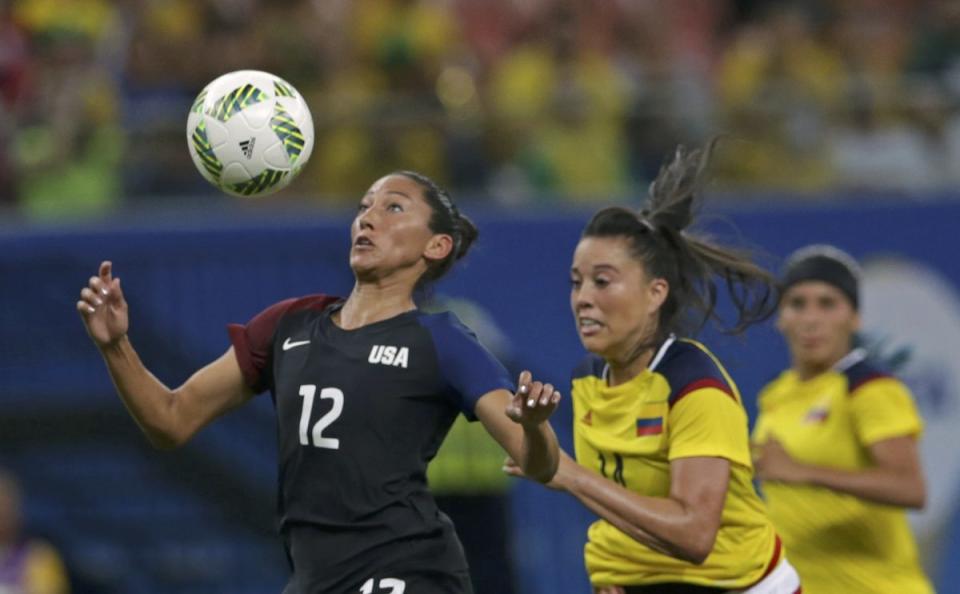If USWNT's Olympic dominance is predictable, attacking evolution is not
The USA stands two wins away from a sixth Olympic women’s soccer final in six editions of the event. Three more wins and the Americans will clinch a fourth straight gold medal and a fifth overall.
Business as usual.
Sort of. Because the Lady Yanks’ tournament so far hasn’t been a doddle, exactly, with a forgettable 2-0 victory over New Zealand, a tight 1-0 result against France, and a first-ever draw with Colombia – after the U.S. went behind, leveled, went ahead, and then gave up the late 2-2 equalizer – seeing them through the group stage and into Friday’s quarterfinal with Sweden.
But the French were the better team for long stretches of the game. And Colombia, which had never gotten so much as a point or a goal against the USA in five tries and lost by a cumulative score of 18-0, was gifted a tie through two uncharacteristic Hope Solo errors, the first of them rather a bad one.
So that’s the bad news.
Now here’s the good: the Americans made a slow start to the 2015 Women’s World Cup as well, laboring through the group stage and not really hitting their full stride until a 2-0 win over Germany in the semifinals and the 5-2 destruction of Japan in the title game.
[Related: Brazil men’s soccer coach defends under-fire Neymar]
But none of that is as significant or acute as the way in which the USA has evolved. For the longest time, and maybe forever, the women’s national team lived and died by the output of a few singular attacking talents. You know the names. Here they are anyway: Michelle Akers; Mia Hamm; Abby Wambach.
For a time, it seemed like Alex Morgan would follow in their footsteps. But a series of ankle injuries and a reform in playing style instigated by head coach Jill Ellis since the World Cup have transformed her. Rather than a galloping speed merchant in pursuit of through balls, she’s now a more static target striker for the rest of the attackers to link up with.
Indeed, the supreme talent on this team is reigning World Player of the Year Carli Lloyd, who is a midfielder by trade, even though Ellis likes to deploy her just underneath Morgan. Her 90 international goals are nothing to sniff at – not to mention sixth all-time in U.S. history – but she remains, at heart, a two-way player who can’t help but chase after balls even in a striker role. Which is all to say that this isn’t a team built around a single attacking player.
What has replaced it is something far more sophisticated. And these Olympics have underscored the remarkable evolution since last year’s World Cup. Some recasting and rebuilding was in order after Wambach and several other mainstays, like the imperious playmaker Lauren Holiday, retired. But what has filled the gaps is a system, rather than a collection of individual talent poured into an unwieldy shape. And a playing style designed to bully opponents with superior athleticism and fitness, rather than outplaying them.
Wambach was a transcendent striker. But her skill set also shackled her team to a direct kind of game that had grown outmoded as other national team programs developed rapidly and figured out how to challenge the USA with their technique. Absent Wambach and the pregnant speedsters Sydney Leroux and Amy Rodriguez, Ellis was without three-quarters of her once impossibly deep striker corps. (We still can’t abide the undefinable Christen Press being defined as a striker, since she does so much more than that.)
Only Morgan remained, and she has been hobbled for much of the past few years. She appears, to the naked eye of this observer anyway, not to be quite as quick as she once was. A natural upshot to her ankle ailments, perhaps.

Ellis, who was always of a mind to modernize the team once she got her hands on it, finally had her chance to remake it around ideas, rather than individuals. She empowered creative players like Crystal Dunn, Press, Megan Rapinoe and the high schooler Mallory Pugh. But most of all, she figured out how to get the most out of Tobin Heath, a singularly gifted ball trickster who had plateaued and even regressed in recent years.
If results have lagged somewhat in this tournament – although an undefeated group stage remains a laudable feat – there is plenty that’s encouraging. This new American team presses high and possesses the ball well into the opponent’s half. It keeps the field wide and moves fluidly through the lines as players interchange spots and roles. It plays better soccer. As a testament to its synchronization, it doesn’t even matter all that much what attacker plays in which spot anymore.
In the not-so-distant past, when the team badly needed a goal, the sum total of the emergency plan was to pelt the ball up to Wambach and her towering headers – a ploy that worked so often it may have proved destructive to the team’s progression. Now, it has so many weapons that it can dial up the pressure without being obvious in its approach. And in a women’s game that now counts half a dozen serious foes at any given time, rather than just one or two, the USA has a large arsenal of weapons to fit whatever need may arise. That’s a sign of real growth, even as results remain more or less the same.
The box score doesn’t reflect the novel ways in which the American women are sustaining their dominance. It may look a tad predictable. But their attack, for the first time in many years, is not.



